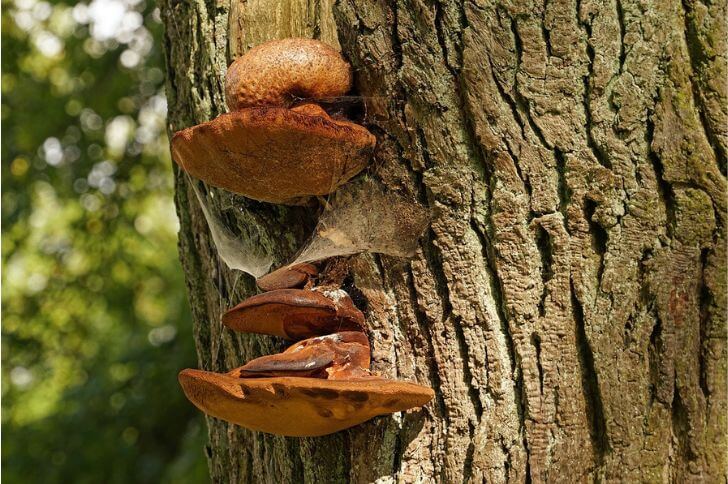Mushrooms are fascinating organisms that can be found in a variety of environments and some species of mushrooms have adapted to grow on trees. Tree-dwelling mushrooms have remarkable abilities that enable them to survive in the challenging environment.
Some mushrooms like oysters offer many benefits to their host trees, from providing nutrients to warding off disease. However, some species of mushrooms that grow on trees harm their hosts. Below we’ll look at both edible and inedible tree fungi.
List of Tree Mushrooms
Don’t eat mushrooms or fungi that have not been classified and identified as edible. Also make sure to cook all edible fungi before consumption.
1. Oyster mushroom
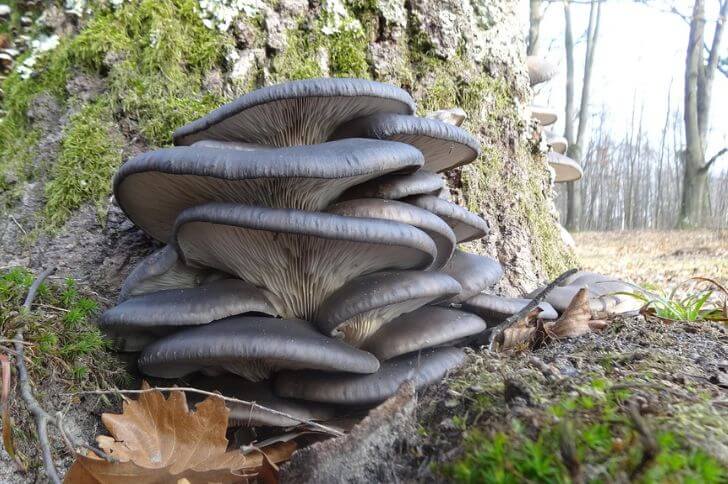
Oyster mushrooms are a type of tree fungi that have an oyster-shaped cap. They are white, tan or gray in color and have a smooth texture. Oyster mushrooms are native to the Eastern United States and Europe.
Oyster mushrooms are most often grown on tree bark. They are mostly found on rotting trees but it has been established that the dying may be as a result of other external factors.
To grow your own oyster mushrooms, simply purchase a log or stump from a local nursery. Once you have your log or stump, drill holes into it and insert the mushroom spawn. Keep the log or stump moist by wrapping it in a wet burlap sack or spraying it with water daily. In 6-8 weeks, your oyster mushrooms will be ready to harvest!
Oyster mushrooms are a versatile ingredient that can be used in many different dishes. You can check some awesome recipes here.
2. Ox Tongue Mushroom
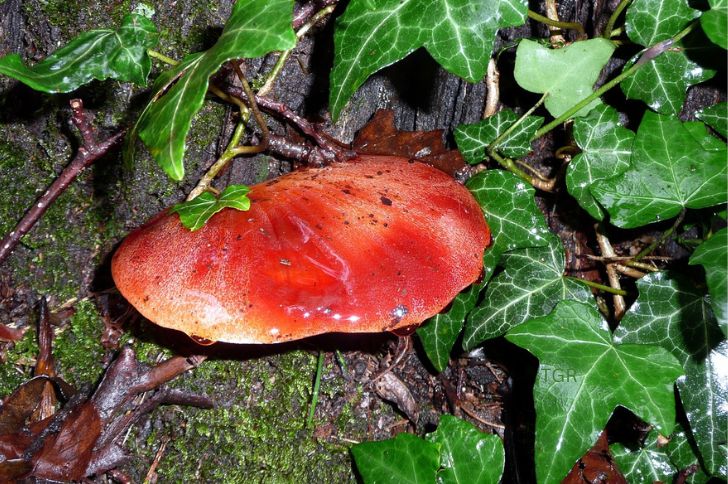
Found all over North America, I think the poor man’s steak or ox tongue mushroom is one of the most unique and identifiable mushrooms on this list. It looks like a tongue sticking out the bark of a tree or stump.
This edible tree fungus grows on sweet chestnuts and oak trees causing a brown rot. Cabinet makers are known to pay a higher price for infected trees.
This tree mushroom is about 3 inches wide with a deep red warty surface. Its inner flesh is thick and looks like real beef, giving it the name poor man’s steak.
The ox tongue mushroom has a chewy texture and is slightly bitter. It is low in calories. This makes it a healthy option for those looking to add more mushrooms to their diet.
3. Sulphur Shelf Mushroom
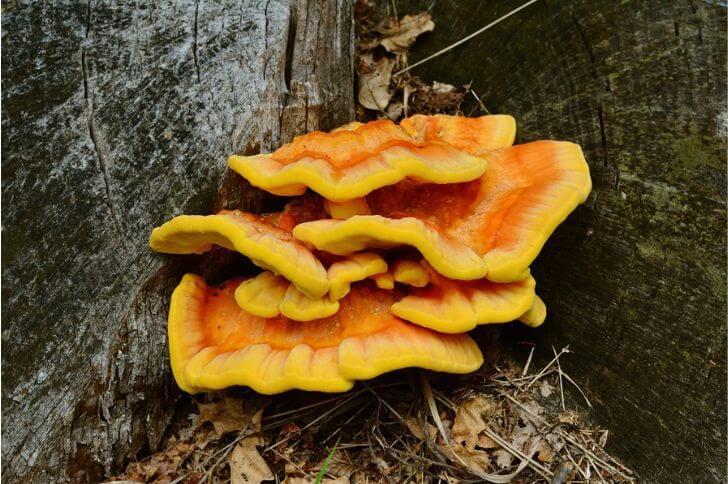
Sulfur shelf mushroom, also known as sulphur polypore, chicken-of-the-woods or crab-of-the-woods, is a fungus that typically grows on dead trees but can sometimes be found on living trees.
The shelves are often found in overlapping clusters and can range in color from yellow to orange. This type of mushroom gets its name from the sulfur-yellow color of its flesh.
Chicken-of-the-woods is often found around dying beech or oak trees. They are edible and have a variety of uses in cooking. They can be sautéed, grilled, or roasted and used as a meat substitute in dishes such as stir-fries, pasta dishes, and pizza. Sulfur shelf mushrooms are also dried and powder to be used as a seasoning or thickener in soups and sauces.
4. Hen of the woods
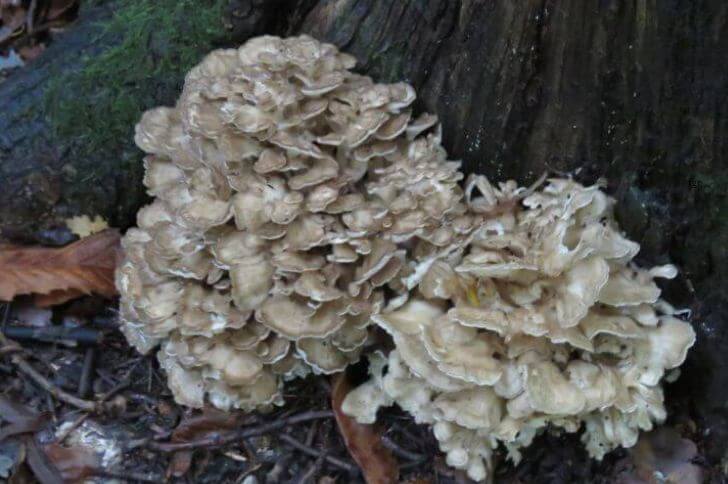
Like most people when I first heard about the hen of the woods I thought it was another name for the sulphur shelf mushroom or chicken of the woods but I was wrong. Hen of the woods and chicken of the woods are two different mushroom species.
Sheep’s head, hen-of-the-wood or maitake is an edible tree mushroom that is easy to spot on red and white oaks.
Check the base of these trees. Unfortunately, hen-of-the-woods parasitic relationship with its host is not so healthy. It causes root rot, leading to death of the host tree.
In late summer and early fall, keep an eye out for these mushrooms while you’re out on your next hike.
This hearty mushroom has a meaty texture and a savory flavor that makes it a coveted ingredient in many dishes.
If you’re lucky enough to find some hen of the woods mushrooms, be sure to cook them within a day or two. These mushrooms are best when they’re fresh, so don’t hesitate to enjoy them while they’re at their peak!
5. Porcelain fungi
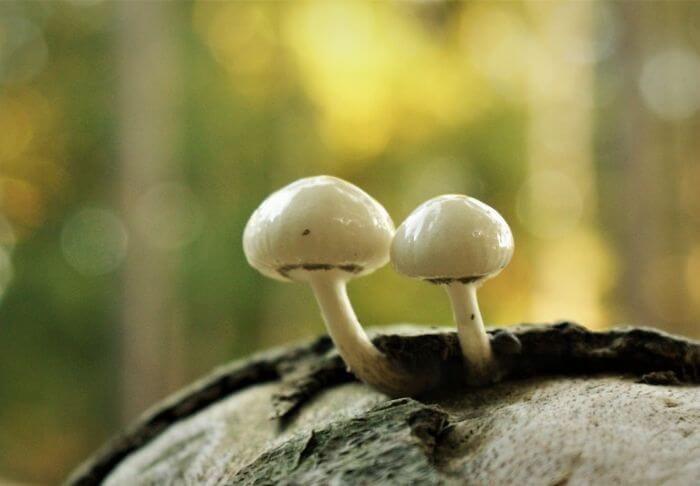
Porcelain fungi are known for their delicate features and slimy appearance. These bark mushrooms are often found in wooded areas, favoring rotting beech. They grow in clusters.
Also, porcelain fungi have a convex-shaped 3.5 inch cap that is slimy and its underside has adnate, well-spaced white gills.
However, porcelain fungi are not just pretty to look at; they also play an important role in the ecosystem. They help decompose wood and other organic matter. This is important because it helps recycle nutrients back into the soil.
When cooking, remember to wash off the slime and just eat the caps.
Related Read: Check different types of yellow mushrooms
6. Jelly fungi
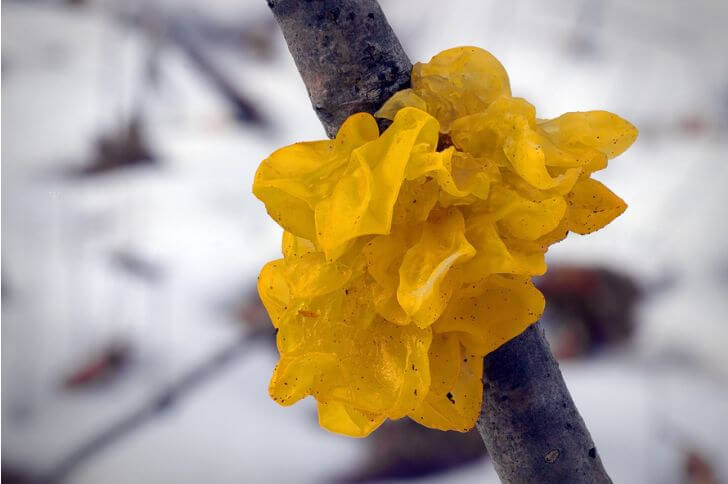
Jelly fungi often appear as a gelatinous mass. These tree fungi are often found on decaying wood in humid environments. Also they are not parasitic, but they do feed on decaying matter.
The jelly fungus family consists of 17 species. The wood ear is the most common member in North America. Also known as tree ear, it occurs on decaying broadleaf trees.
Jelly fungi are composed of individual cells connected to each other by thin strands of cytoplasm. Each cell is filled with water, and the jelly-like substance helps the cells to retain moisture, forming an ear-shaped mushroom.
Wood ears are edible but they can’t hold a candle to the oyster mushrooms above.
7. Lion’s Mane
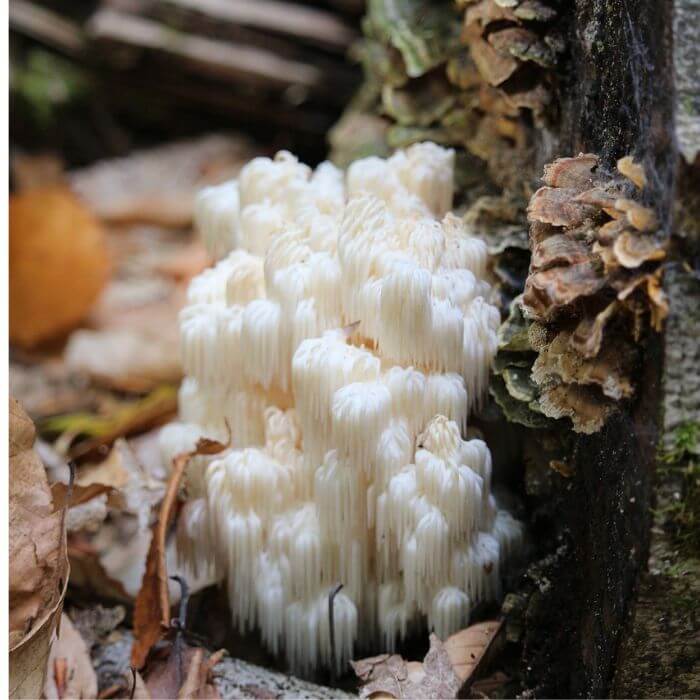
Want a benefits-packed tree mushroom? You can’t go wrong with lion’s mane mushrooms. It is a large, shaggy mushroom that resembles a lion’s mane.
It is native to North America and Europe. Like other mushrooms on this list, lion’s mane grow on dead coniferous trees. Is this mushroom edible? Yes, the bearded tooth fungus or lion’s mane mushroom are edible. Young fruiting bodies are the best.
8. Dryad’s saddle
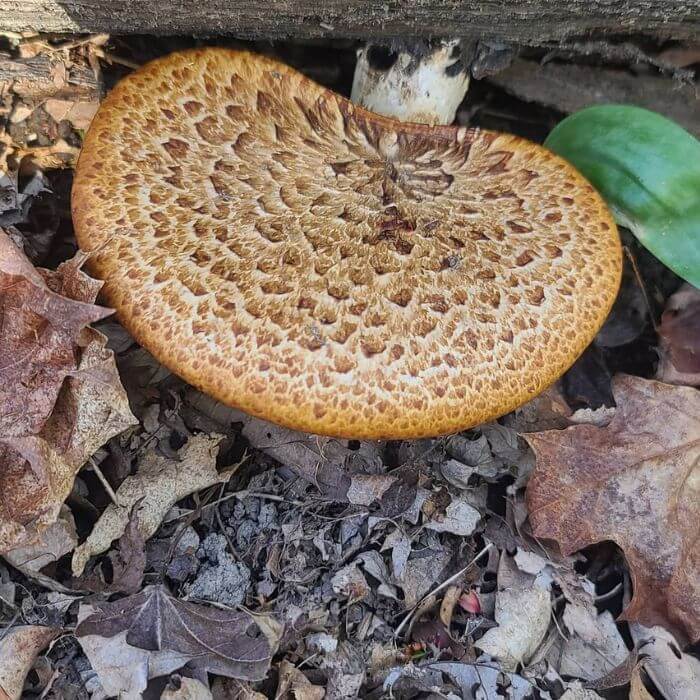
Dryad’s saddle or the Pheasant’s back mushroom or the Polyporus squamosus is a large, shelf fungus that typically grows on the trunks. This large tree mushroom is often found in spring and attaches itself to decomposing wood of elm, box elder and silver maple trees.
The fruiting body of the tree fungus is composed of a large 4-24-inch cap. Its tan upper surface looks scaly. This large mushroom has a thick short stalk. Dryad’s saddles grow in clusters or layers.
It is edible when it is young and fresh, but it quickly becomes tough and bitter with age. It does not have gills.
9. Golden Brown Honey Mushroom
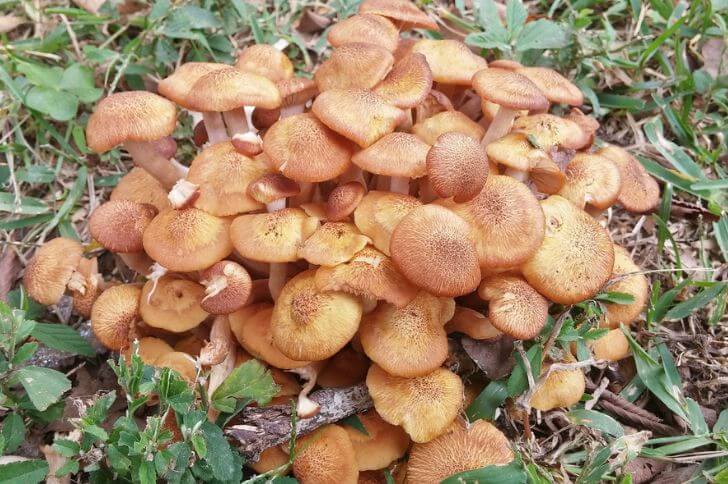
The genus Armillaria, commonly known as honey fungus, is one of the most remarkable fungi found in Europe. The mushrooms they produce can cause significant damage to trees and other woody plants.
Armillaria grows in many habitats and soil types throughout the world, typically near or on decaying wood or buried roots. Their mycelia often form thick mats that can spread rapidly underground to infect new areas.
Not only do they cause damage to trees but their fruiting bodies have a distinctive odor and flavor which makes them a sought-after edible mushroom for chefs worldwide.
10. Common Split Gill
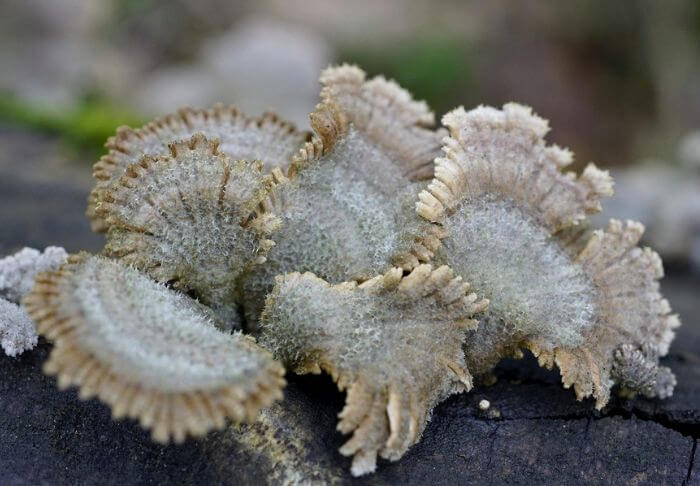
Commonly consumed in Mexico, splitgill mushrooms that get their name from the way that their gills split when they mature. They are typically white or cream colored and have a hairy cap.
These mushrooms can be found growing on decaying logs or in moist, shady areas. Splitgill mushrooms are edible, but they are not considered to be a choice mushroom for cooking due to their bland flavor.
Inedible tree fungi
11. Turkey tail mushrooms
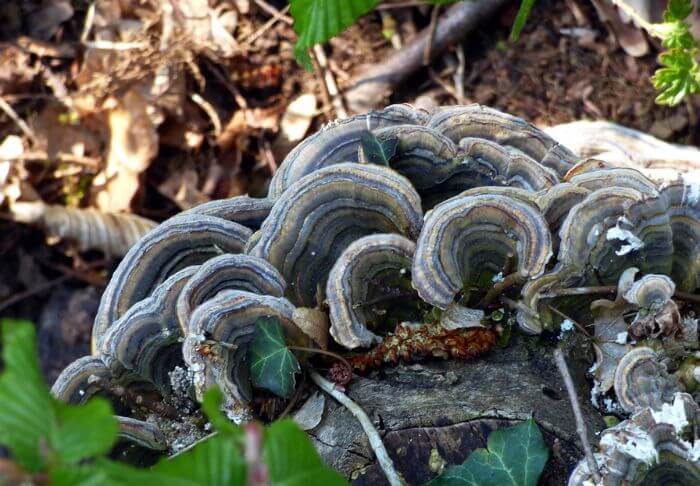
Another type of tree mushroom that you should know about is the turkey tail. This tree fungi grows in layers on stumps or logs of hardwood trees. To identify this tree fungus check for a stalkless mushroom with various color patterns. Colors vary depending on the tree host.
Are turkey tail mushrooms edible? No, these wild mushrooms are not edible.
12. Rosy Veincap
Preferring shaded areas in hardwood forests, the Rosy Veincap or wrinkled peach or netted rhodotus is a beautiful mushroom species that grows on rotting elm and maple trees.
This tree stump fungus gets its name from its rosy colored pores. Its cap is about 0.8-2.4 inches in diameter and is deeply veined, forming a beautiful pattern. Its pink stem is about 0.6-1.2 inches with vertical white fibers. Note the flesh is also pink.
Are netted rhodotus edible? Its edibility is unknown and like other red colored mushrooms that experts are yet to classify, we recommend you don’t eat a rosy veincap.
13. Shaggy scalycap
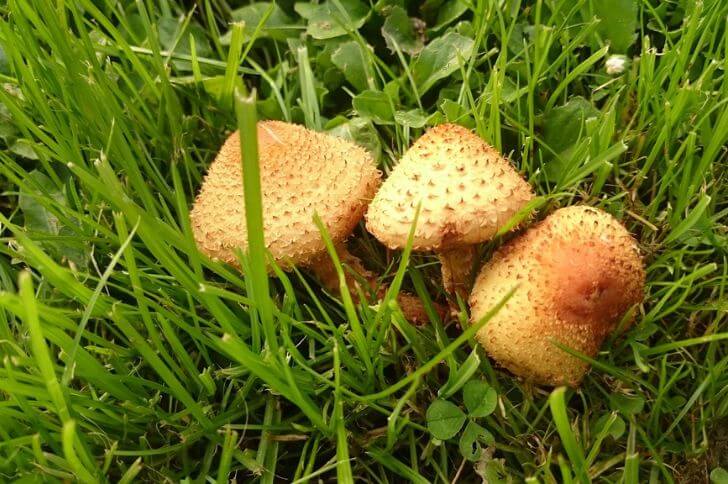
A shaggy scalycap is a type of mushroom that gets its name from its shaggy, scales-like cap. The scales are actually tiny spines that cover the entire surface of the cap.
These spines help the mushroom to release spores, which are then spread by wind and animals. The shaggy scalycap is found in wooded areas all over the world and typically grows on dead or dying trees.
14. Cryptoporus volvatus
The cryptoporus volvatus are tree bark fungi that are found on conifers. It prefers trees that have been killed by insects or fire. The fruiting body is about 2.5 inches and yellowish or tan in color.
Like the ox tongue mushrooms above, it causes a brown rot on the tree trunks. Their flesh is white. These brown rot mushrooms are not edible.
15. Green elfcup
One of the smallest mushrooms that grow on trees are the green elfcups. Also known as green wood cups, they have goblet-shaped fruiting bodies and are less than 1 inch in diameter. The top of the cup is smooth, while the inside is lined with small spores.
The scientific name is Chlorociboria aeruginascens. It is common in North America, specifically on the west coast, growing on coniferous trees. It typically grows on deadwood, and can be found from June to November.
16. Artist’s conk
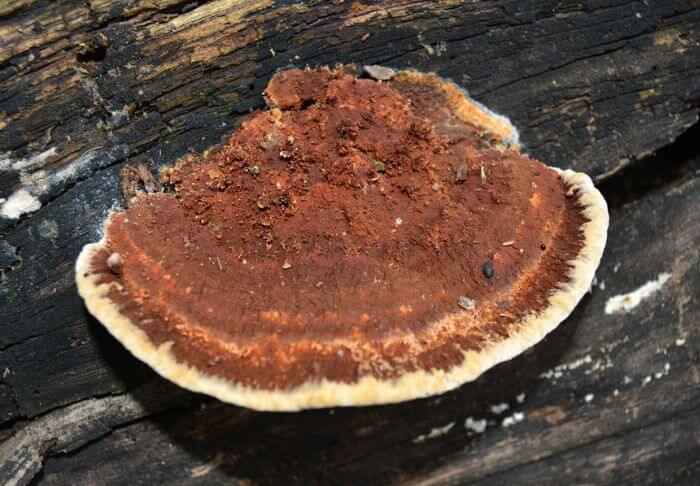
Another unique shelf-like mushroom that causes the death of beech trees are the artist’s conk. This mushroom starts out as a small shelf and gradually grows to about 29 inches when fully mature. The mushroom has a really tough fruiting body that is also woody.
Artist’s conk is inedible but can be dried and used for teas. Also, this tree trunk fungi is used by artists, giving it the unique name.
Sources:
https://en.wikipedia.org/wiki/Fistulina_hepatica
https://mdc.mo.gov/discover-nature/field-guide/hen-woods-maitake
Hi There,
My name is Jenny. I’m the Chief Editor at Try Green Recipes and besides making yummy and healthy foods for my kids, grandkids, and friends. I’m new to the blogging world but I believe what I have to share is unique and will bring joy to your home. If you are adventurous and want try something tasty, let’s get started.
